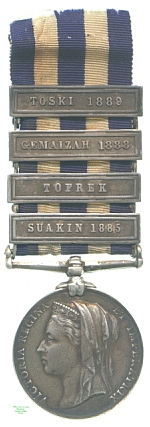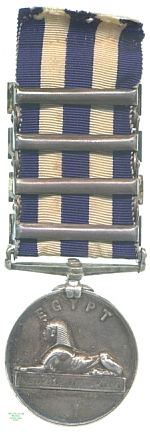
Obverse, a bust of Queen Victoria with veil

Reverse, the Sphinx on a pedestal facing left

Obverse, a bust of Queen Victoria with veil |

Reverse, the Sphinx on a pedestal facing left |
The serious weakening of Ottoman Egyptian power under foreign influence led to increasing attempts to shed Egyptian dominion in the Sudan, where in 1881 Sheikh Muhammad Ahmad ibn al-Sayyid 'Abd Allah was proclaimed as Mahdi (the legendary final redeemer of Islam). He and his allies soon threatened to remove the Sudan entirely from the Khedive's control. Several serious defeats of Egyptian forces in 1884 led to a concerted British campaign in defence of Egyptian claims, but control could not be recovered. The British withdrew their forces to Egypt and to Khartoum, where General Gordon defended the city whilst awaiting a relief column that, beset by Mahdist attacks, arrived too late.
After this disaster Suakim, on the Red Sea, remained the last British bridgehead in Sudan, and was subject to a number of sieges. The Suakin Field Force, formed to defend this outpost, were repeatedly engaged by Mahdist troops without much conclusion beyond heavy casualties to either side, until the eventual complete British withdrawal in 1890.
The bars on this medal indicate participation in four such engagements, of which several were extremely small. It was awarded to E. H. Middleton, whose rank and unit are not given but who was almost certainly with the 20th Hussars, the only British unit present at Toski. The Watson Collection also includes a later medal of his. Lester Watson acquired this one, probably with the other, at some point before 1928.